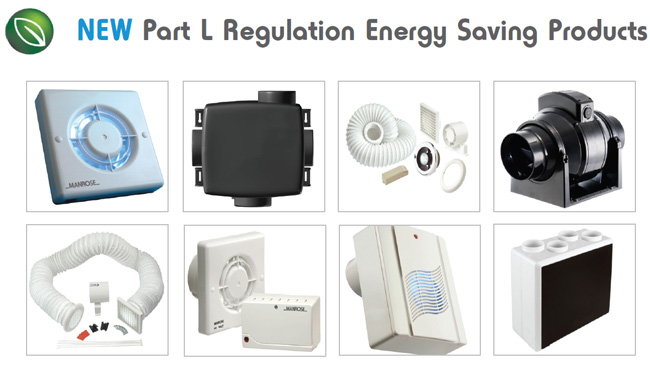 New Part L Regulation Energy Saving Products - Energy Efficiencies
New Part L Regulation Energy Saving Products - Energy Efficiencies
With the 2010 changes to the Building Regulations, as well as minimum airflow requirements (Approved Document F) there are now minimum energy efficiencies required (Approved Document L). The new range from Manrose offers a complete product range and all designed to comply with the requirements. The new regulations require a minimum specific fan power as minimum energy efficiency. This is measured in watts per litre a second of airflow extracted and all models in the new range comply. The table below shows the minimum specific fan powers required to comply with the new building regulations.
New and replacement Manrose systems
- Fan Power a. Mechanical ventilation systems should be designed to minimise electric fan power. Specific fan power (SFP) should not be worse than: i. 0.5 Watts per litres per seconds for intermittent extract ventilation systems ii. 0.7 Watts per litres per seconds for continuous extract ventilation systems iii. 1.5 Watts per litres per seconds for continuous supply and extract with heat recovery ventilation systems
- Heat Recovery Efficiency a. The heat Recovery efficiency of balanced mechanical ventilation systems incorporating heat recovery should not be worse than 70%.
- Controls a. Intermittent Mechanical extract ventilation systems should be operated by Controls local manual switches or automatically by a presence sensor b. All other mechanical ventilation systems should have manual or automatic control of the boost facility
Installed Performance – It needs to comply
In the new regulations there is now a requirement for the installer to sign off the installation. This will include airflow measurements. The new Green range from Manrose are designed to comply with the installation requirements as set out in the domestic Ventilation Guide as part of Approved Document F When installing there are a few simple rules that will help as shown below:Left: The inner radius of any bend should be greater or equal to the diameter of the ducting being used. If the radius is reduced, the resistance of the bend and the volume of the air being extracted will decrease(see image on the left). Right: Ensure flexible ducting is installed without peaks or troughs(the image on the right).
Installation Introduction
- This guide provides basic guidance for persons installing fixed ventilation systems in new and existing dwellings to help to comply with installation and commissioning requirements in the 2010 part F and the 2010 part L of the building regulations for England and Wales. Rectangular or circular rigid duct should be used wherever possible, if necessary, flexible ducts maybe used, however, these lengths should be kept to a minimum, connecting to rigid ductwork as soon as possible.
- You are limited to a maximum of 1.5m of flexible ductwork when connecting to axial fans; for centrifugal fans you are limited to 6 metres (for extract rates of 6 to 30 l/s) and 3 meters (for extract rates of 31 to 60 l/s). You are able to incorporate up to 2 bends in a system up to 30l/s, this then reduces to 1 bend for higher extract rates.
- Flexible ducting should be pulled taught to minimise resistance, this is considered to be achieved if extended at least 90% of the total duct length.
- Ductwork should be insulated when it passes through unheated areas and voids.
- Horizontal Ducting, including ducting in walls, should be installed with a slight slope downwards away from the fan to prevent backflow of any moisture.
- Vertical ducting will require a condensate trap in order to prevent backflow of any moisture into the product.





